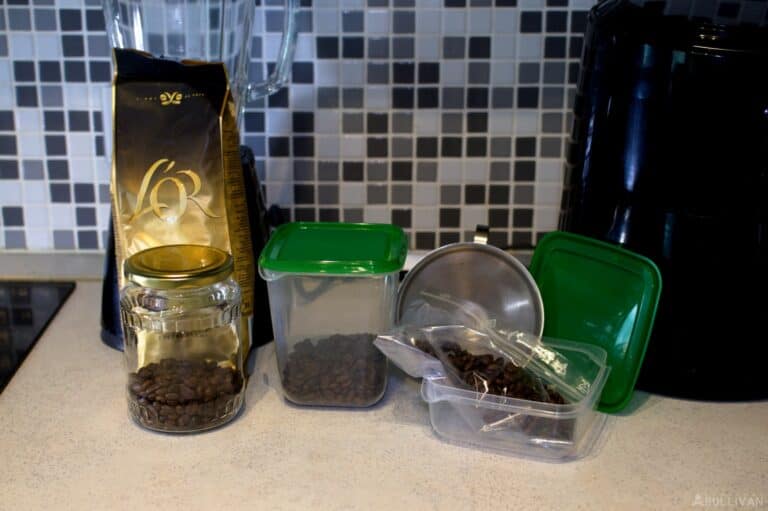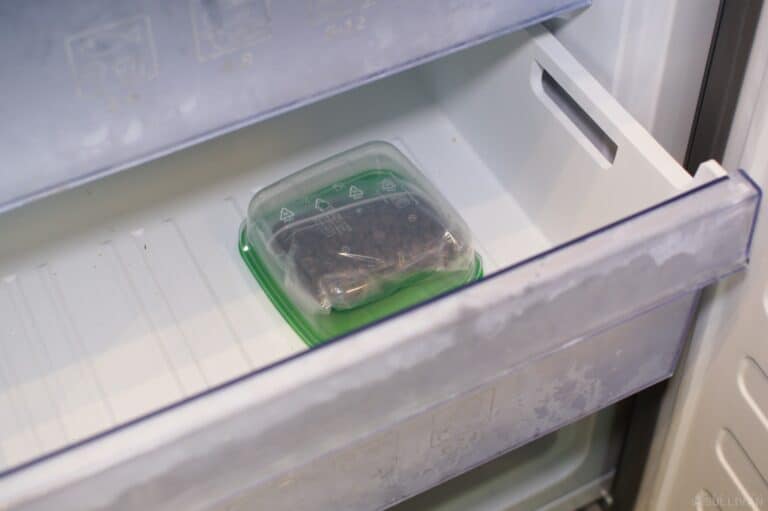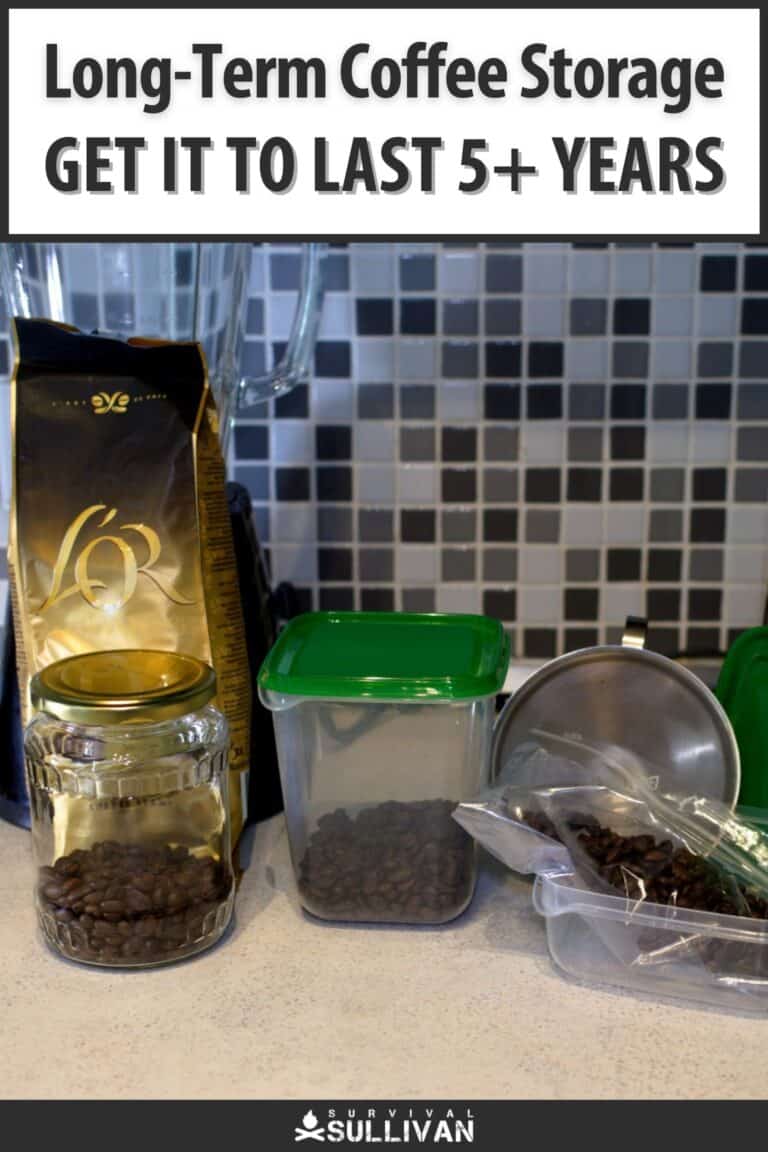It’s no exaggeration to say that coffee quite literally makes the world go round when it comes to work and industry. I’m serious! A caffeine-fueled coffee break has literally changed modern labor forever.

It’s a fascinating subject, and you should look into it. But on a more practical level, most people just can’t get going in the morning without that hot cup of joe.
Accordingly, as self-reliant folks, it’s in our best interest to lay in a large supply of coffee for the long haul if we, or anyone in our family, is a coffee fiend.
But out of all the foods that we might store, it is coffee that has one of the most variable shelf lives: it might last for only a few months, or could last for more than 5 years!
The secret is in how the coffee is prepared, packaged, and stored. Do it wrong, and your coffee might spoil long before you ever pull it out of your stash.
To help prevent that from happening I’ll be telling you everything you need to know about long-term coffee storage in this guide.
Follow these tips and procedures, and I promise your coffee will stay fresh for years…
Does Coffee Really Go Bad Over Time?
Yes, coffee can and will go bad over time. This is because coffee contains oils that will oxidize, or even go rancid.
When the oils in coffee are exposed to air and moisture, they begin to break down and lose their flavor. This process is called oxidation. As the oils continue to break down, they can eventually go rancid and produce a foul smell and taste.
To slow down the oxidation process, it’s important to store coffee properly. Coffee should be stored in an airtight container away from moisture, heat, and light.
It’s also recommended to buy whole-bean coffee and grind it just before use. This will help preserve the freshness and flavor of the coffee.
Can’t You Trust the Expiration Date on the Package?
Not really. The expiration date on a package of coffee is typically a best-by date. This means that the coffee will be at its freshest and best quality up until that date, but it doesn’t necessarily mean that it is unsafe to drink if you brew it after that.
In fact, most coffee will be totally safe to drink quite a while after the best-by date has passed!
However, it is important to note that the longer coffee sits after the best-by date, the more likely it is to lose its flavor and aroma. So, while it may still be safe to drink, it may not taste as good as fresh coffee.
What Happens to Coffee That’s Too Old?
When coffee is too old, the oils begin to oxidize and the coffee loses flavor- no matter how well packed it is! In addition to losing its flavor, coffee that is too old might even develop a foul taste. This is because the oils in the coffee have gone rancid.
Understand that the rate at which coffee goes bad depends on several factors, including the type of coffee, how it is packaged, and the environment in which it is stored.
Coffee exposed to air, moisture, and light will go bad much quicker than coffee stored in an airtight container protected from these factors.
In general, it is best to consume coffee within two weeks of roasting for optimal flavor and quality.
What’s the Actual Shelf Life of Coffee?
As I said, the shelf life of coffee varies depending on several factors, including the type of coffee, how it is prepared, the packaging, and the storage conditions…
For example, whole bean coffee that is stored in an airtight container in a cool, dry place away from light will last much, much longer than ground coffee that is exposed to air and moisture.
Similarly, coffee that is vacuum-sealed or stored in nitrogen-flushed factory packaging will last longer than almost any coffee that is packaged in a regular plastic bag.
Again, as previously mentioned coffee can still be safe to consume even after its “best-by” date has passed: the flavor and aroma will deteriorate over time, though, regardless of whether or not it is safe.
Below are my assessments for various common types of coffee, their shelf-lives, and other criteria that might affect your choice of whether or not to buy it for long-term storage:
1. Ground Coffee
- Sealed: 6 months
- Opened: 1 to 3 months
Ground coffee is the standby for most coffee drinkers. It is common, convenient and easy to use. However, it has some serious drawbacks for long-term storage.
Ground coffee has been roasted already, which hurts shelf life, and a much greater surface area than whole bean, and that means it is far more susceptible to oxygen and “off-gassing” that will ruin the flavor and freshness of your coffee, and eventually spoil it.
Left sealed, it is okay for short-term or intermediate-term storage in your stash.
2. Whole Beans, Roasted
- Sealed: 1 to 2 years.
- Opened: 6 to 9 months.
Not as convenient as ready-ground but much better for long-term storage. Whole bean coffee has a much more stable shelf life, and when kept sealed can last for a couple years.
It remains fresher for longer because it has a smaller surface area on which oxygen acts to ruin those essential oils that make coffee, coffee! Once opened, however, you should try to consume it within 6 to 9 months or else rotate it out.
3. Whole Beans, Green
- Sealed: 5 years or more.
- Opened: 12 months, appx.
Now we are talking! If you want the best way to store coffee for a long time, and you still want that legit coffee flavor, green coffee beans are your answer.
These unroasted beans have a tremendously long shelf life when stored properly, and that’s because they were not roasted in the first place; that speeds up spoilage.
The key here is still in proper storage: an airtight container in a cool, dry place away from light and moisture. The problem, obviously, is that you must have the know-how and the means to roast the beans yourself – otherwise no coffee!
4. Instant Coffee
- Sealed: 10 years or longer!
- Opened: 12 months, appx.
A bad word among real coffee fans… If all you need is caffeine and some vaguely coffee-like experience, instant coffee offers virtually indefinite shelf life.
You can store it in a pantry for a decade and it will last and stay safe. This is because it is prepared in a special way that removes all of the moisture that promotes spoilage, leaving only coffee solids behind. This does not mean it tastes great, though.
But, the Achilles’ heel of this stuff is the fact that it starts to spoil far faster as soon as the factory seal is breached; that dried-out coffee will then start to hungrily absorb all moisture from the air, dramatically reducing its shelf life.
5. Brewed Coffee
- Sealed: days to weeks.
- Opened: hours to days.
Brewed coffee is a special case, one not really fit for any long-term storage. What makes coffee so special is the combination of flavor and aroma; these two characteristics are integral to the enjoyment of a good cup of joe.
Unfortunately, neither will last in any significant form after brewing has taken place whether you pack it yourself or buy a can or bottle from the store.
At room temp or refrigerated, you have only hours to a few weeks at most before it becomes undrinkable or even spoils in case it contains dairy products. Nice for a treat, but a bad bet for prepping.
What are the Ideal Storage Conditions for Coffee?
The ideal storage conditions for coffee are cool, dry, and dark. Coffee should be stored in an airtight container away from moisture, heat, and light.
This will help to maximally preserve the flavor and aroma of the coffee whatever form it is in. Freezing can add up to 50% additional storage life to any given kind of coffee detailed above. For extended storage, freezing is the ideal way to prolong the shelf life of any type of coffee.
However, it’s important to ensure that the coffee is stored in suitable container to prevent moisture and other odors from getting in.
Coffee is itself not too vulnerable to freezer burn, but any moisture that gets in, and then freezes, can ruin it. This is why repeated openings of the freezer door cause problems.

When you’re ready to use the coffee, remove it from the freezer and let it come up slowly to room temperature before opening the container.
I highly recommend you pop it in the fridge for about a day, then bring it out to room temp to complete the thaw. Never try to defrost your coffee in the microwave or oven; that won’t work like you hope!
How Should You Pack Coffee for Long-Term Storage?
Coffee always does best in its factory-sealed package, assuming it is vacuum sealed and nitrogen purged. However, if you’re looking for long-term storage that you can do yourself, vacuum packing is a great option.
Vacuum packing removes all of the air from the container, be it bag or jar, and so reduces the risk of oxidation and helps to keep the coffee fresh.
Mylar bags are another great option for long-term storage since they are inherently airtight if not damaged. These bags are made from a special material that all three of our “enemies”- moisture, oxygen, and light- from entering.
Mylar bags can also be used in conjunction with vacuum-packing or oxygen absorbers for added shelf life.
Other viable, but inferior, methods of packing coffee for long-term storage include using glass jars or resealable plastic freezer bags. Just understand that the better your container and the better your conditions, the longer your coffee will last.
How Much Coffee Should You Store at Once?
The amount of coffee you should keep in your stockpile depends on your personal preferences and consumption habits. If you drink coffee every day and go through it quickly, you may need to stash a truly sizeable amount for a rainy day!
However, if you prefer to stock up only for emergencies as a hedge against fatigue, or for others consumption, you may want to store only a few bags, just in case.
For the real caffeine fiends, you’ll need to track how much coffee you consume daily, figure out how much coffee grounds are required to produce that much, then purchase and store accordingly.
Let’s say that you are a statistically average coffee drinker and drink two cups of coffee a day, each being 8 ounces.
If you use a standard coffee maker, it should take anywhere from 1 to 3 tablespoons of grounds to make one 8-ounce cup of coffee, so we’ll split the difference and say 2 tablespoons is the benchmark for an eye-opening cup of coffee worth drinking.
You might need a little more or a little less depending on your own and your family’s preferences.
Now, knowing how many tablespoons we need, we can figure out how much actual coffee we need if we know what a tablespoon of grounds weighs.
Generally, a single tablespoon of coffee weighs around ¼ of an ounce, but that can vary significantly depending on the coarseness of the grind. Using our recipe above, that means half-an ounce of coffee
With all these variables in mind, the following guidelines can be used as rules-of-thumb for ground coffee, but remember that the best way to establish your own consumption rate is to track it for a week and extrapolate from there.
| Listed Measures in Appx. Net Ounces, of Ground Coffee | 1 Month Supply | 3 Month Supply | 6 Month Supply |
|---|---|---|---|
| 1 Person | 30 ounces / 1.8 pounds | 90 ounces / 5.4 pounds | 180 ounces / 10.8 pounds |
| 2 People | 60 ounces / 3.6 pounds | 180 ounces / 10.8 pounds | 360 ounces / 21.4 pounds |
| 4 People | 120 ounces / 7.5 pounds | 360 ounces / 21.4 pounds | 720 ounces / 42.8 pounds |
As you can see, a family of coffee drinkers will really go through the coffee, even drinking just two cups a day!
If everyone is drinking many more cups a day, or likes really strong coffee (meaning more tablespoons needed per cup) you will need a lot more coffee than what is shown here.
And as always, storing more coffee will require more space. When deciding how much coffee to store, consider the storage space you have available and how much coffee you will realistically need in a given scenario.
When is the Best Time to Rotate Coffee?
The best time to rotate coffee is whenever it is needed, and preferably before the known “bad” date we learned about above. When pulling your old coffee from stores to either use up in your daily life, or just to discard, remember to always take the oldest coffee out first!
This is known as the “first in, first out” principle, and following it means that most of your stock will always be fresh and trustworthy.
To facilitate this, always date your stores with marker or labels so you can know precisely how old any given quantity is. You can’t trust the “Best by” date as we learned.
As with any stored perishable supplies, it’s important to periodically inspect your coffee and check its freshness to ensure that it hasn’t indeed gone bad.
But to do that, you’ll need to break the seal, meaning you’ll be accelerating spoilage! It is a tradeoff, but real experience and knowledge of what you can expect from your “emergency” coffee is priceless.
One way to test the freshness of your coffee is to smell it. If the coffee smells stale or rancid, it’s likely past its prime. Assuming it does not smell obviously horrid, brew a cup and taste it. If the coffee tastes flat or sour, it’s likely gone truly bad.
Know that, ultimately, it is only by performing regular rotation and sample tests with your stored coffee that you can determine how long it can truly last before it goes bad.


Tom Marlowe practically grew up with a gun in his hand, and has held all kinds of jobs in the gun industry: range safety, sales, instruction and consulting, Tom has the experience to help civilian shooters figure out what will work best for them.

what about the Keurig type cups??
they probably can’t be vacuum packaging process would likely crush them, but perhaps a supply could be mylar bagged with oxygen absorbers to convert the bag’s atmosphere to nitrogen.
any thoughts on this ??
Thanks
We have name brands of coffee 7-8 years old that still taste fine.I’m no coffee gourmet but morning without coffee is unthinkable.
Just Sayin,
My coffee routine is to perk it and pour into thermos bottles and refrigerate it after it sits for a day. I heat a cup for two minutes in the microwave and it is good. I drink it in a week and repeat.
I was cleaning and found a sealed can of dark roast great value dark roast coffee that expired in 2017. I haven’t opened it yet to test the freshness, so I was looking up if it would be safe to drink. If it pops from the vacuum seal and smells good, I will perk it.
Good article. What about freeze drying either ground or whole bean coffee?